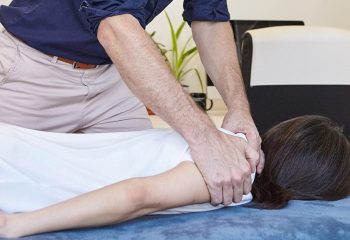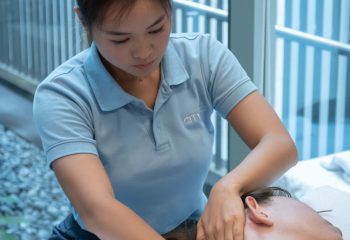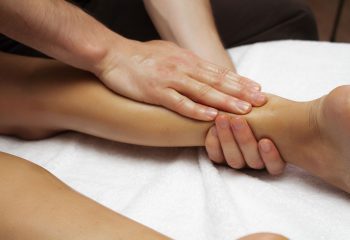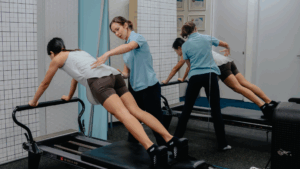Congratulations, new moms! Welcoming a bundle of joy into your life is an incredible experience. However, along with the joy of motherhood, some women may encounter discomfort and pain in their pelvic region after childbirth. This condition, known as pelvic girdle pain (PGP), can be distressing and impact daily activities. The good news is that there are effective ways to alleviate PGP and regain your pelvic health. In this blog post, we’ll explore the causes of PGP, the role of postpartum exercises in providing relief, and the importance of pelvic health physiotherapy in your recovery journey.
What Causes Pelvic Girdle Pain After Childbirth?
 During pregnancy, your body undergoes significant changes to accommodate the growing baby. Hormonal changes, increased weight, and the shifting of your pelvic bones are factors that contribute to the development of pelvic girdle pain (PGP) after childbirth. Let’s delve deeper into each of these factors to understand how they can lead to PGP:
During pregnancy, your body undergoes significant changes to accommodate the growing baby. Hormonal changes, increased weight, and the shifting of your pelvic bones are factors that contribute to the development of pelvic girdle pain (PGP) after childbirth. Let’s delve deeper into each of these factors to understand how they can lead to PGP:
- Hormonal Changes: During pregnancy, your body experiences hormonal fluctuations, including an increase in relaxin hormone levels. Relaxin helps relax the ligaments and joints in the pelvic area to allow for the expansion and flexibility needed for childbirth. However, the increased levels of relaxin can cause the ligaments and joints to become overly lax and unstable, leading to PGP.
- Increased Weight: Pregnancy involves weight gain as the baby grows, and this extra weight places additional strain on the pelvis and surrounding structures. The pelvic joints, such as the sacroiliac joints and the symphysis pubis joint, bear the brunt of this increased load. The excess weight can cause these joints to become stressed and strained, resulting in pain and discomfort.
- Shifting of Pelvic Bones: As your body prepares for childbirth, the pelvic bones naturally shift and expand to accommodate the baby’s passage through the birth canal. This shifting can cause misalignment or instability in the pelvic joints, leading to PGP. The asymmetrical movement of the pelvic bones during labor and delivery can further contribute to this condition.
The joints in the pelvic area, such as the sacroiliac joints and the symphysis pubis joint, may become unstable or misaligned, causing pain and discomfort. The additional stress placed on these joints during labour and delivery can further exacerbate the issue.
These factors combined create an environment where the pelvic joints are susceptible to misalignment, instability, and increased stress. This can result in pain, stiffness, and difficulty in performing daily activities.
Understanding the underlying causes of PGP helps highlight the importance of addressing these factors through appropriate postpartum exercises and treatments.
How Can Postpartum Exercises Provide Relief for Pelvic Girdle Pain?
Postpartum exercises play a crucial role in providing relief for pelvic girdle pain (PGP) by addressing the underlying causes, improving muscle strength and flexibility, and promoting overall pelvic health. However, to ensure optimal results and safe recovery, it is essential to involve a pelvic health physiotherapist in your postpartum exercise journey. Here’s why their expertise is so valuable:
- Individualised Assessment: A pelvic health physiotherapist will conduct a thorough assessment of your condition, considering factors such as the severity of PGP, pelvic alignment, muscle imbalances, and any other specific postpartum challenges you may be facing. This assessment helps tailor an exercise program that meets your unique needs, ensuring maximum benefit and minimising the risk of exacerbating your pain.
- Targeted Exercise Prescription: Pelvic health physiotherapists specialise in prescribing exercises that specifically target the muscles, joints, and ligaments involved in PGP. They can guide you through a range of exercises that focus on strengthening the core muscles, improving pelvic stability, and promoting proper alignment. By following their expert advice, you can address the root causes of PGP, gradually reduce pain, and restore normal function.
- Correct Technique and Progression: Performing exercises with incorrect technique or progressing too quickly can potentially worsen PGP or lead to other issues. A pelvic health physiotherapist ensures that you understand and execute exercises correctly, emphasising proper posture, alignment, and muscle activation. They will also guide you in progressing your exercises gradually, ensuring that your body is ready for increased intensity or load, reducing the risk of injury or discomfort.
- Manual Therapy Techniques: In addition to exercise prescription, pelvic health physiotherapists may use manual therapy techniques to complement your treatment. These techniques, such as soft tissue massage, joint mobilizations, and trigger point release, can help relieve muscle tension, improve joint mobility, and reduce pain. Manual therapy, when combined with targeted exercises, can enhance the effectiveness of your overall treatment plan.
- Education and Self-Management Strategies: A significant aspect of pelvic health physiotherapy is empowering you with knowledge and self-management strategies. Your physiotherapist can educate you about proper body mechanics, posture, and lifestyle modifications that can support your recovery and prevent future occurrences of PGP. They can also guide you in understanding your body’s signals, providing advice on pain management techniques, and teaching you how to adapt exercises to your changing needs as you progress through your postpartum journey.
By involving a pelvic health physiotherapist in your postpartum exercise regimen, you benefit from their specialised knowledge and experience in treating PGP. They provide a comprehensive approach to your recovery, focusing on addressing the underlying causes, improving muscle strength and coordination, and supporting your overall pelvic health.
Remember, each woman’s postpartum experience and PGP symptoms can vary, so seeking individualised care from a pelvic health physiotherapist ensures that your exercise program aligns with your specific needs and goals. Their expertise and guidance can make a significant difference in your recovery, helping you regain comfort, function, and confidence in your postpartum journey.
What Are Some Effective Postpartum Exercises for Alleviating Pelvic Girdle Pain?
Pelvic Floor Exercises for Pelvic Girdle Pain
 Kegels and other pelvic floor exercises play a crucial role in strengthening the muscles that support the pelvic area. These exercises involve contracting and releasing the muscles used to control urine flow. Begin by identifying the muscles you need to target (as if you were stopping the flow of urine) and gradually increase the duration and intensity of the contractions.
Kegels and other pelvic floor exercises play a crucial role in strengthening the muscles that support the pelvic area. These exercises involve contracting and releasing the muscles used to control urine flow. Begin by identifying the muscles you need to target (as if you were stopping the flow of urine) and gradually increase the duration and intensity of the contractions.
Hip Bridges for Pelvic Girdle Pain
Lie on your back with your knees bent and feet flat on the floor. Engage your core muscles and lift your hips off the ground, creating a straight line from your shoulders to your knees. Hold for a few seconds, then slowly lower your hips back down. Repeat this exercise, focusing on using your glute and core muscles.
Deep Squats for Pelvic Girdle Pain
 Stand with your feet shoulder-width apart. Slowly lower your body into a squatting position, ensuring your knees track over your toes. Keep your back straight, and don’t let your knees extend beyond your toes. Hold the squat briefly, then rise back up to the starting position. Deep squats help strengthen the muscles around the hips, thighs, and buttocks, promoting stability in the pelvic area.
Stand with your feet shoulder-width apart. Slowly lower your body into a squatting position, ensuring your knees track over your toes. Keep your back straight, and don’t let your knees extend beyond your toes. Hold the squat briefly, then rise back up to the starting position. Deep squats help strengthen the muscles around the hips, thighs, and buttocks, promoting stability in the pelvic area.
Pelvic Tilts for Pelvic Girdle Pain
 Lie on your back with your knees bent and feet flat on the floor. Gently tilt your pelvis backward, pressing your lower back into the floor. Hold for a few seconds, then release. This exercise helps strengthen the abdominal muscles, supporting the pelvic area.
Lie on your back with your knees bent and feet flat on the floor. Gently tilt your pelvis backward, pressing your lower back into the floor. Hold for a few seconds, then release. This exercise helps strengthen the abdominal muscles, supporting the pelvic area.
Low-Impact Cardio for Pelvic Girdle Pain
Engaging in low-impact cardiovascular exercises, such as walking, swimming, or cycling, can improve circulation, reduce inflammation, and promote overall fitness without putting excessive strain on the pelvic joints. Start with shorter durations and gradually increase the intensity and duration as your body adjusts.
When Should You Start Postpartum Exercises for Pelvic Girdle Pain Relief?
Every woman’s postpartum journey is unique, and it’s essential to listen to your body and consult with your pelvic health physiotherapist before starting any exercise regimen. In most cases, you can begin gentle pelvic floor exercises soon after delivery, even while still in the hospital. However, it’s important to gradually progress to more challenging exercises as your body heals and gains strength. Aim to incorporate postpartum exercises into your routine within the first few weeks after childbirth, but be mindful of any discomfort or pain during or after the exercises.
What Precautions Should Be Taken During Postpartum Exercises for Pelvic Girdle Pain?
While postpartum exercises can be highly beneficial, it’s crucial to exercise caution and take certain precautions to avoid exacerbating your condition. Consider the following tips:
- Start gradually: Begin with gentle exercises and gradually increase intensity and duration as your body becomes stronger and more resilient.
- Listen to your body: Pay attention to any pain or discomfort during and after exercising. If an exercise causes significant pain, modify or discontinue it and consult with a healthcare professional.
- Maintain proper posture: Proper alignment is essential during exercises to prevent additional strain on the pelvic area. Engage your core muscles, keep your back straight, and avoid overarching or slouching.
- Stay hydrated: Hydration is essential for overall health and muscle function. Remember to drink plenty of water before, during, and after exercising.
- Use proper equipment: Wear comfortable, supportive footwear and clothing that allows for unrestricted movement. A supportive sports bra can also provide added comfort during exercise.
How Long Does It Take to Experience Relief from Pelvic Girdle Pain through Exercises?
 The timeline for experiencing relief from pelvic girdle pain (PGP) through exercises can vary from woman to woman. Factors such as the severity of PGP, individual healing abilities, adherence to exercise routines, and involvement of a pelvic health physiotherapist can influence the duration of recovery.
The timeline for experiencing relief from pelvic girdle pain (PGP) through exercises can vary from woman to woman. Factors such as the severity of PGP, individual healing abilities, adherence to exercise routines, and involvement of a pelvic health physiotherapist can influence the duration of recovery.
Consistency is key when it comes to postpartum exercises for PGP. Regularly performing prescribed exercises, following the recommended frequency and duration, and gradually increasing intensity and difficulty can lead to progressive improvements over time. By staying committed to your exercise routine, you provide the body with consistent stimuli to strengthen the muscles, improve stability, and promote proper alignment, ultimately aiding in the relief of PGP.
While the timeline for experiencing relief from PGP through exercises varies, engaging a pelvic health physiotherapist can help expedite your recovery process. Their expertise in assessing, diagnosing, and treating PGP, combined with personalised exercise programs and additional interventions like manual therapy, ensures that you are receiving optimal care. By working closely with a pelvic health physiotherapist, you can benefit from their guidance, support, and targeted interventions, which can significantly shorten the duration of PGP and improve your overall postpartum experience.
It’s important to remain patient and committed throughout your recovery journey, as healing and progress take time. By consistently following your exercise program, seeking guidance from a pelvic health physiotherapist, and listening to your body, you can enhance your chances of experiencing relief from PGP and regaining your pelvic health.
If you are ready to start your healing journey, book a consultation with our expert women’s pelvic health team here.
What Role Does Core Strength Play in Relieving Postpartum Pelvic Girdle Pain?

Developing core strength is paramount in relieving postpartum pelvic girdle pain. The core muscles, including the deep abdominal muscles and the muscles of the pelvic floor, provide stability and support to the pelvis and spine. Strengthening these muscles can help alleviate strain on the pelvic joints, reduce pain, and improve overall functionality. Incorporating exercises that specifically target the core, such as planks, side planks, and bird dogs, can be highly beneficial for pelvic girdle pain relief. Our pelvic health experts can help ensure you are engaging the right muscles whilst performing these exercises, improving the efficiency of your exercise routines.
Is Physiotherapy Effective in Relieving Postpartum Pelvic Girdle Pain?
Absolutely! Pelvic health physiotherapy is an essential component of postpartum recovery and can significantly aid in relieving PGP. A pelvic health physiotherapist specialises in assessing and treating pelvic floor dysfunction, including PGP. They can provide personalised treatment plans tailored to your specific needs, which may include manual therapy techniques, exercises, and education on proper body mechanics. Working with a pelvic health physiotherapist can help you regain pelvic strength, improve posture, and manage pain effectively.
In conclusion, pelvic girdle pain after childbirth is a common condition that can impact a woman’s quality of life during the postpartum period. Fortunately, through targeted postpartum exercises and the support of pelvic health physiotherapy, relief and recovery are attainable.
Remember to consult with a qualified and experienced physiotherapist before starting any exercise program, listen to your body, and be consistent in your efforts. Your pelvic health is essential, and with time and proper care, you can regain strength, alleviate pain, and enjoy the precious moments of motherhood to the fullest.
Ready to embark on your recovery journey from PGP? Book a consultation with our pelvic health physiotherapist today.










